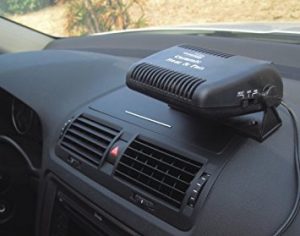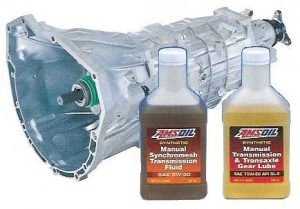If Al Gore is right, all we’d need to do is collectively rev our SUVs’ engines and the cold of winter would shoo away – or at least dial back a bit.
It hasn’t worked so far. Hence climate change rather than global warming. It gets around the embarrassment of cold that still comes – as harsh as ever – and stays for months at a time (this is called winter) notwithstanding all those SUVs doing the C02 Nasty.
Well, how about some winter tips that will actually warm you – if not the earf – up?
Ceramic plug-in heater –
The one thing electric cars have over “IC” cars is instant-on heat, even on the coldest days. That’s because electric cars have electric heat – while IC car heaters rely on warm engine coolant to warm up the car. It’s a great way to make use of the engine’s waste heat – and for this reason, using the heat requires very little power – only the slight draw of the electric fan – but the problem is the engine has to be warm before you get any heat. And that takes several minutes, at least.
Several long minutes when it’s 13 degrees out.
Solution? A plug-in ceramic heater to bridge the gap between a cold engine – and a warm interior. They make heat via electricity – which your IC car produces (via the alternator) immediately, as soon as the engine is running. Just plug in to your car’s cigarette lighter – er, power point – and you will be warm (or at least not cold) right now . . . instead of several long minutes from now.
The best news? Ceramic heaters are as cheap as $20.
Cruise Amazon or your local car parts place and see for yourself.
Remote engine start –
Why wait for your car to warm up when you can warm it up remotely – and go from warm house to warm car? Press your key fob, the engine starts – and the car warms up – while you’re getting ready to go.
Once you are ready, the car is ready.
Many new cars offer this feature as a factory option. But what if you haven’t got a new car? Add it to your old car. With a few exceptions – really old cars and cars with manual transmissions – it’s a relatively easy – and not-expensive – thing to add. Most car stereo/electronics stores can handle the job – and the cost (parts and labor) shouldn’t be more than about $300.
How much is being warm worth to you?
A windshield-sized piece of cardboard –
This one will keep you warm by keeping you from having to stand outside in the cold, scraping off an ice-covered windshield.
Before you park the car for the night – this assumes you have to park outside, of course – place the piece of cardboard over the windshield and use the windshield wiper arms to hold it in place.
When you go out in the morning, simply remove the cardboard and – voila! – a clean, ice-free windshield. This field expedient tip is really the ticket when the weather turns to freezing rain.
Best of all, it’s our favorite price … free!
You can also buy flexible/fabric windshield covers made to fit your specific car’s windshield. These, obviously, are not free – but the advantages are they fit your car’s windshield exactly, can be shaken off/folded and stowed (hard to do with a chunk of cardboard) and, of course, will last longer.
Synthetic lubes –
It sounds mildly pornographic and in a different way, it will make you feel good. Well, it’ll make your car feel better – which ought to make you feel good.
Synthetics – in particular, gear lube as in a manual transmission/transaxle/axle – suffer brutal cold temperatures far less than non-synthetic lubricants. They still flow readily – while non-synthetics tend to thicken up or become more viscous.
The German army in World War II discovered this the hard way outside of Moscow in the winter of 1941. Temperatures reportedly fell to -40 and the German army’s tanks wouldn’t run and its guns wouldn’t fire because the lubricants they were using could not deal with extremes of cold and became so thick that mechanical parts could not move freely.
We don’t have to deal with such extremes – usually. And your car will probably still start and run, even if it is really cold out.
But it will smoother – and warm up faster – if you have synthetic lube in the engine, the transmission and axle. The difference on a cold day is immediately obvious; your transmission will shift more smoothly as a for-instance and you will sometimes notice a difference in rolling resistance vs. the same car with non-synthetic lube. The engine will also usually start easier – and come up to normal operating temperature sooner, which means you get heat inside the car sooner.
Synthetics are already in wide use as Original Equipment (OEM) fill because the friction reduction they provide is a “free” way to slightly increase a car’s gas mileage; it also reduces wear and tear.
Both are nice perks – along with the faster warm-up times!
. . .
Got a question about cars – or anything else? Click on the “ask Eric” link and send ’em in!
If you like what you’ve found here, please consider supporting EPautos.
We depend on you to keep the wheels turning!
Our donate button is here.
If you prefer not to use PayPal, our mailing address is:
EPautos
721 Hummingbird Lane SE
Copper Hill, VA 24079
PS: EPautos stickers are free to those who send in $20 or more to support the site. Also, the eBook – free! – is available. Click here. Just enter you email in the box on the top of the main page and we’ll email you a copy instantly!












Interesting about that ceramic heater. A witch’s heart is a coal-burning furnace compared to the winter weather we get here.
My old Honda has remote start but a manual transmission. The procedure is so involved to use it I’ve never bothered to.
Another tip would be to reuse an old (but thin) blanket or bedsheet to cover the front windshield. Use the front doors to close in the ends and hold it in place. It’s so true that lotta times if you miss that damn 5 minute window in which to depart, your morning commute will be hell…..
The Al Gorean crowd is a bit pissed at yours truly , I write and question the contribution of the trace gas CO2( I do know one for certain about co2-it makes plants grow better) I need a little more proof then those crazy charts they spew out, because the climate has swung wildly in ages past.Water Vapor is one heck of a lot better heat trapper then CO2, go outside on a clear ,low humidity night and a lot of times the temperature will drop 30 or more degrees from the daytime high( one clear April morning in the era of the seventies it was in the single digits around here) now go outside on a Muggy night and see how much the temperature drops, not nearly as a dramatic temperature swing.
What I wish the alarmists to do is a simple temperature experiment using science fill a large closed area with regular atmosphere gases and fill a similar structure with ever-increasing amounts of CO2 and using a longwave IR emitter,direct the energy through the structure and see how much longer it takes the air in the structure to lose its heat to ambient, I for the most part respect science, not feelings and jealousy.It seems no one has risen to the challenge yet, no one will even answer my queries.That pesky thing called science is rather impartial.
PS: Another reason it isn’t called global warming is that such nomenclature implies that it’s a global problem, and as such, all nations and all people are responsible and must take measures to reduce their greenhouse gas emissions. Yet only middle-class and working-class Americans are held culpable and must dramatically change their lifestyles. Somehow, countries like China and India get away with turning their countries into literal dumps. And elites in all countries keep on jetting around the world, living in mansions, driving around in big SUVs and other gas guzzlers, eating Waygu beef and exotic fish flown in from the four corners of the world, and supporting wars with their fuel-hogging and pollution-spewing tanks, battleships, and fighting planes.
To make a log story short, the idea of climate change isn’t about controlling the weather…it’s about controlling you and me.
I think you make a pretty good point. Bryce.
The good news: By 2050, winter will be a thing of the past. Snow will be nonexistent and the ice caps will have completely melted.
The bad news: Cities such as New York and Venice will be completely submerged.
The great news: This includes Washington DC.
8, I missed that GMC diesel pickup. I called the guy the last time I posted about it to ask if I could drive it to the shop for a checkup and it was gone. He said he had several and would let me know the next time he sold one. that one was a 4WD, and I wanted a 2WD, though.
Your post is hung up in spam jail. I read it in the comments page of the dashboard but couldn’t respond to it there, thus the new reply at the top.
Do keep in mind, if you live in one of those over regulated places, that idling your vehicle (especially if it’s diesel) is often illegal. Yes, you can be fined for trying to warm up your car.
Wondering what the consensus is for keeping a car in the garage in winter vs out on the driveway? I prefer keeping it in the garage year around not only because it is always around room temperature but also because it is nicer to work on things like waxing and cleaning the interior.
However, dad (who has so much stuff piled in his garages) claims that keeping a vehicle outdoors is actually better because any frozen liquid won’t thaw out and rust out the body, and as long as the engine oil flows there’s nothing wrong with an extremely cold engine, diesels not included obviously.
Like all things, it depends. for the freeze-thaw environment I’m in a warm garage is universally better. A cold garage isn’t going to be much different unless the heat it can hold from the sun makes the difference between frozen and not frozen. In which case the car itself probably can do that.
Usually keep the ice and snow off the car in an unheated carport.
I did the amsoil thing on my ranger manual trans, big difference.
I remember getting in my Subaru one very cold morning and not being able to shift into reverse. Had to call my boss and explain that I was going to be late because my car was frozen.
Good ideas, all of them. My daughter bought me a windshield cover for Christmas last winter and it’s great, but the cardboard cover is a great idea too. With all the shipping cartons I accumulate by living in the sticks and shopping online, a good suppl of cardboard is at hand.
I wonder how well the ceramic heater would work, though. My daily driver warms up pretty quickly. Maybe I won’t need one of those unless the new ‘little ice age’ arrives. Switching to the Amsoil transmission fluid is on my list of things to have done when my car goes in the shop for its timing belt replacement. Might as well get that done when the transmission is being serviced.
I have my first pickup in 30 years that doesn’t have a block heater I’ve installed. Put that baby on a timed receptacle and have warm air no matter the temp and you don’t have to watch the oil gauge go out of sight. My 93 Chevy benefited with Amsoil in the transmission although it came with synthetic fluid. Changing gear lubes and esp. transmission lube make a difference no matter what you drive.
My first big rig was a good example of changing lube. I mentioned it wasn’t shifting as slickly to a guy who’d been trucking for decades. He told me to change it to mineral oil since it needed no sheer additive. I did and it helped it. I did it every 50,000 miles and that transmission never gave me a minute’s trouble.
The engine oil is where Amsoil really shines. Back when I first started they didn’t have a flush so I used Mobil 1 for a few thousands miles and it looked like diesel engine oil. Draining that and installing Amsoil was just the ticket though. The Mobil 1 didn’t do much quietening on the valve train but the Amsoil shut up the tick. Amsoil stopped a leak on my diesel and actually made it use less oil than a quart in 3,000 miles like Rotella T. Probably nobody uses synthetic compressor oil and that is the key to getting one to last….and not leak.
Ed, did you buy your neighbors diesel pickup? It sounded like a good deal.